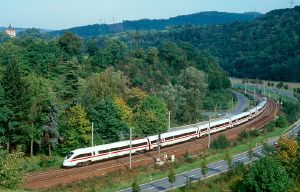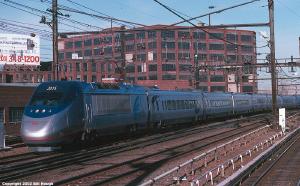Quality of regulations
In the 1950s, passenger comfort tests were undertaken on the New York, New Haven and Hartford Railroad ("New Haven"). Result:
3 inches of unbalanced superelevation were comfortable for the passengers, with
the carriage used for that test. This does not mean different passengers or different test methods than in Europe. The
explanation is simple: The carriage had a rather soft suspension, and tilted to the outside of the curve.
The result of this comfort test was later transformed into a safety regulation.
If you, the reader, are a young student of political science, and need a topic for your thesis: This one should allow a nice case study into the accidental installation of a disfunctional rule. The author hasn't yet understood, how this could happen, but knows of similar amazing government activities in his own country.
The higher limits for European standard passenger trains have two reasons:
- This regulation has been restricted to providing safety. Providing comfort to the passengers, or avoiding coffee spills in the diner, is the task of the railroad, not a government task. In some European countries, the general legal limit is considerably higher than the railroad's own operational limits for most of its lines, especially in France with its very high limit.
- Limits have been revised along the progress of railway technology. Since that test on the "New Haven" was undertaken, some of the European railroad rulesets have got higher numbers for unbalanced superelevation for two times.
Just like European railroads, Amtrak has successfully tested its equipment with higher values for unbalanced superelevation, and asked for changes. For an example, see Department of Transportation, Federal Railroad Administration, FRA Docket No. RST-97-1, Petition for Waiver of Compliance; Cant Deficient Passenger Train Operation, issued March 31, 1997, which can be found within this textfile in a compilated version. The results aren't impressive: There are waivers by the Federal Railroad Adminstration (FRA), that allow to use European limits of the 1950s for some routes.
Regular checks, wether the railroad ruleset doesn't stop modernization, should be good practice of a parliament, and should be based on independent expertise. Some of the most successful European passenger train operations would have been impossible without rewriting the rules first.
Curve speed: Regulations and technical possibilities
Trains have three speed limits.
- A comfort limit for the passengers.
- A safety limit for the passengers, which describes an acceleration that could throw down standing passengers.
- A safety limit for the train, at which it could derail, encounter fatigue failure of its wheels, or push the track out of position.
The highest curve speeds in regular passenger service are achieved with an unbalanced superelevation of 11.8 inches, which is about equal to an acceleration of 0.2 g. This is beyond the safety limit of many trains. Operation is made possible by a reduction in maximum axleload to 17 tons or less. Distributed power is the best way to achieve such low values.
Examples for such trains are the type 411 EMUs of Deutsche Bahn AG, which use the tilting technology of Italian "Pendolino" trains. On the picture, one of them travels through the Saale river loop near Kaulsdorf. In order to qualify for a waiver, that allows up to 11.8 inches of unbalanced superelevation, several safety requirements have to be met. Since the axleload is safety critical, and reservation isn't mandatory in German long distance trains, one requirement is a continous check of axleload, which stops the train from using its higher speed in an overload condition of too many standees.
The highest curve speeds in the USA are achieved by the Acela Express. For the track between New Haven and Boston, it has
a waiver for operation at 7 inches of unbalanced superelevation. This means, that the Acela is allowed to use the same curve
speed as non-tilting TGVs (or multiple units) in France.
Adding results to the comparison on page 4 gives the following table therefore:
| curve radius | superelevation | speed limit 1 |
|
|---|---|---|---|
| Amtrak Cascades, tilting | 1000 feet | 4 inches | 48 mph |
| TGV, non-tilting | 1000 feet | 4 inches | 53 mph |
| Acela Express, tilting | 1000 feet | 4 inches | 53 mph |
| Baureihe 411 EMU | 1000 feet | 4 inches | 63 mph |
In the USA, trains like the type 411 EMU are not allowed to operate. US regulations require a very high carbody strength for political reasons, which adds several tons of weight to a vehicle. If this mass is added to a European tilting EMU or DMU, it is no longer safe to operate at 11.8 inches of unbalanced superelevation, because the maximum safe axleload is exceeded.
The Acela Express is built to these strength standards. It is nearly double as heavy as European or Japanese tilting trains. Instead of restricting the axleload to 16 tons or less, the powercars weigh 25 tons per axle. No safety authority would allow values like those for the German 411 or 610 for this train, because the forces at the wheel-rail contact point would be too high for safe operation.
As a result, the "Acela Express" looses about half an hour between New York and Boston, compared to best practice in tilting train usage. (It also looses at least half an hour, compared to the calculations of US railroad engineers in the 1960s.) If this half hour of running time from New York to Boston needs to be cutted away by infrastructure investment instead, a three-digit number of millions in additional public investment will be needed at least. A similar situation will be found with almost all upgrade projects for curvy track.
Climbing grades: Regulations and technical possibilities
Another result of US regulations is low performance on steep grades. The additional weight is paid for with either low speed, or excessive power requirements. On 3.5 % of grade, a rather new Amtrak loco like the "Genesis" P42 (4200 hp, 133 tons) could pull 2 or 3 cars at speeds, that might be acceptable for modern passenger traffic. US passenger railroads avoid steep grades like the plague therefore.
In sharp contrast, new highspeed lines are built with grades of 3% in Japan, 3.5% in France and 4% in Germany. This kind of route layout reduces the tunnel and bridge mileage in difficult terrain, and allows huge cost savings. On old infrastructure, there are examples for halfhourly traffic with doubledeck commuter trains on 5.5% singletrack, like the Höllentalbahn in Germany.

